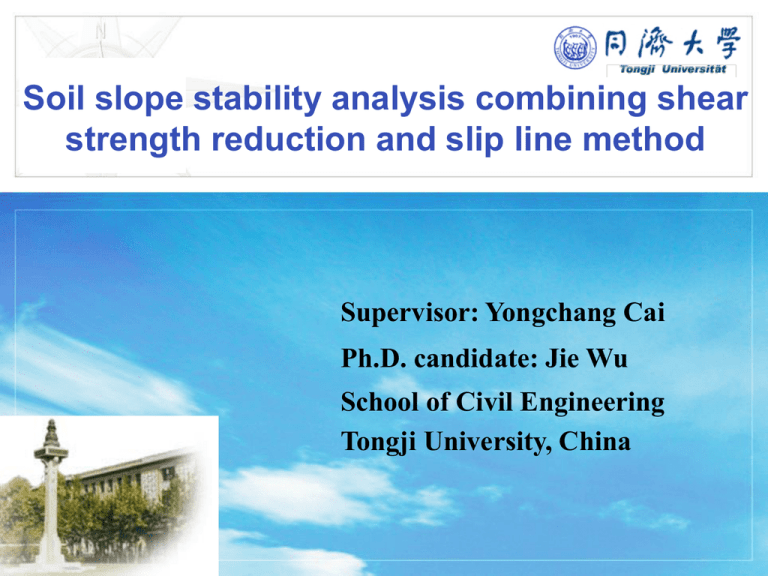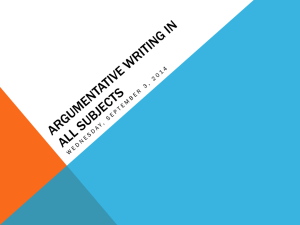PowerPoint Template
advertisement

LOGO Soil slope stability analysis combining shear strength reduction and slip line method Supervisor: Yongchang Cai Ph.D. candidate: Jie Wu School of Civil Engineering Tongji University, China LOGO Research background Predicting the stability of soil slopes is a classical problem for both of practicing engineers and academics. Picture from: http://www.ccma.vic.gov.au/soilhealth/photos.htm LOGO Research background Two main challenges need to be confronted when dealing with soil slope 1. The Determination of potential slip lines of the soil slope 2. The calculation of corresponding safety factors Picture from: http://ceae.colorado.edu/~regueiro/images/slope.jpg LOGO Research background When the limit equilibrium method is applied 1 The stress strain behavior of soil are often neglected 2 The calculation models are often overly simplified 33 Arbitrary assumptions are usually introduced to ensure static determinacy LOGO Research background In the past several decades, there have been growing interests in Numerical slip line theory, which is developed from the classical slip line theory. As a particular method for soil slope stability analysis, the potential slip line surfaces can be tracked in an efficient way. Slip line Start points of the search LOGO Content Slip line method for evaluating slope stability Application in soil slope stability analysis Combination of Shear strength reduction and slip line method Conclusion LOGO Slip line method for evaluating slope stability Traditional Slip line theory For plane problem, when failure occurs, it has two failure planes(lines) and the angle μ between the failure plane(line) and the principal stress orientation is specific. As shown in figure below, 1 and 2 represents the maximum principal stress orientation(θ) and the minimum principal stress orientation, respectively. And α and β represent two failure planes(lines). : : dy tan( u ) dx dy tan( u ) dx 7 LOGO Slip line method for evaluating slope stability Traditional Slip line theory M-C material For M-C material: For Tresca material: Tresca material However, Traditional Slip line theory is based on rigid-plastic assumption and it can only solve some simple problems. LOGO Slip line method for evaluating slope stability Numerical Slip line theory n y cos 2 x sin 2 2 xy sin cos ( )sin cos (cos 2 sin 2 ) y x xy n LOGO Slip line method for evaluating slope stability n 0 2 xy 1 when x y,1 = arctan 2 x y when , = 1 arctan 2 xy +90 y x 1 2 x y n 3 cos 2 1 sin 2 n ( 3 1 )sin cos LOGO Slip line method for evaluating slope stability So, the slope safety can be defined as below: (1 sin 2 3 cos 2 ) tan c K ( 3 1 )sin cos For the minimum of K, solve the equation K 0 3 1 (45 arcsin( )) 2c *cot 3 1 Thus, the two surfaces of the smallest anti-shear safety factor can be expressed as: 3 1 (45 arcsin( )) 2c *cot 3 1 LOGO Slip line method for evaluating slope stability By linking the critical slip surface of each point, the slip surface group of slopes can be obtained. The safety factors of the slip surfaces can be calculated by the formula below. The slip surface corresponding to the minimum safety factor is the critical slip surface of slopes stability. n F j 1 ij tan ij cij lij n j 1 ij lij LOGO Application in soil slope stability analysis The following is the procedure of slip line theory to analyze soil slopes stability, that is, the stress distribution and its value in soil slopes is calculated by Ansys and then the slip line theory is applied to find the potential slip surface based on the stress status of the slopes. 1 Modeling in Ansys 2 Stress distribution in slopes 3 Searching the potential slip line surfaces 4 critical slip surface and safety factor LOGO Example 1 This example was provided by Australian Computer Aided Design Society (Donald and Giam, 1992). γ(KN/m3) E(Kpa) μ 25 1e7 0.2 c(KPa) Ψ(°) 1e3 38 Reference calculation result: Geometric model Safety factor=1 In Limit Equilibrium State Finite element mesh LOGO Example 1 (cont.) Contours of maximum principal stress (Elastoplastic) Critical slip surfaces (Elastoplastic) Contours of maximum principal stress 𝜎1 (Elasticity) Critical slip surfaces (Elasticity) LOGO Example 1 (cont.) Orientation of slip lineline (Elasticity) Orientation of slip (Elastoplastic) LOGO Example 2 Another benchmark from Australian Computer Aided Design Society Layer 1 material γ/KN m-3 Layer 1 19.5 Layer 2 Layer 3 Ψ/° E/KPa v 0 38.0 1.0*104 0.25 19.5 5.3 23.0 1.0*104 0.25 19.5 7.2 20.0 1.0*104 0.25 c/KPa Layer 2 Layer 3 Reference safety factor is 1.400 The orientation of slip line Plastic range indicated in red color LOGO Example 2 (cont.) Critical slip surface, Fs=1.487 Shear strength reduction method, Fs=1.450 Limit equilibrium method, Fs=1.400 LOGO Application in soil slope stability analysis Based on the calculation results of the 2 examples, some conclusions can be drawn as follows: When the soil slope, especially its top area, is not in the plastic state, there is a dramatic change of the orientation of the slip line and the slip surface tracked is singular at corresponding area, and the factor of safety is also not minimum. 1. The shear strength reduction method can be employed to reduce the material parameters until materials of the slope approaching the plastic state. Then the slip surface calculated maybe not singular and would be more like the real one. 2. the defect that the slip surface cannot be easily obtained by the conventional shear strength reduction method can also be corrected. LOGO Combination of shear strength reduction and slip line method The central concept of the SSR method is very simple. Successively reduce some factors in the shear strengths of slope materials until the finite element model does not converge to a solution, which means the failure occurs. The critical factor at which failure occurs is taken to be the factor of safety. The following is the combination of the shear strength reduction and slip line method. 1 Modeling in Ansys 2 Set a range of different strength reduction factors 3 4 5 Stress distribution in slopes Searching the critical slip surfaces Comparing the shape of different slip surfaces LOGO Combination of shear strength reduction and slip line method Plastic range indicated in red color, strength reduction factor is 1.3 The critical slip line, safety factor is 1.073 LOGO Combination of shear strength reduction and slip line method Plastic range indicated in red color, strength reduction factor is 1.4 The critical slip line, safety factor is 1.008 LOGO Combination of shear strength reduction and slip line method Plastic range indicated in red color, strength reduction factor is 1.45 The critical slip line, safety factor is 0.997 LOGO Conclusions The slip line method is time efficient and no priori assumptions have to be made when it is employed to the stability analyze of the soil slope. The slip surface is singular and not as smooth as the real one if the material, particularly in the top of the slope, is in elastic state rather than plastic state. The combination of strength reduction and slip line method can correct the defect that the slip surface can not be directly get by the strength reduction method, and is an effective way to track the slip surfaces and to evaluate soil slopes stability. 2 LOGO Thank you very much for your attention ! Acknowledgements The authors gratefully acknowledge the support of national science and technology support program (2011BAB08B01), and program for new century excellent talents of ministry of education of China (NCET-12-0415).






